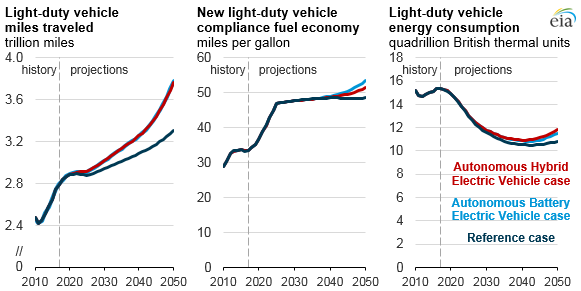June 18, 2018
Autonomous vehicles are one of the main sources of uncertainty in the future of transportation energy consumption in the United States. Autonomous vehicle technology has the potential to change travel behavior, vehicle design, energy efficiency, and vehicle ownership. According to analysis in EIA’s Annual Energy Outlook 2018 (AEO2018), the widespread adoption of autonomous vehicles could lead to an overall increase in light vehicle travel and, depending on how those vehicles are powered, a small increase in transportation energy consumption.
On-road vehicles, including light-duty cars, buses, commercial trucks, and freight trucks, are significant consumers of energy in the United States, accounting for 31% of total end-use energy. Light-duty vehicles alone account for 21% of total end-use energy consumption. EIA projects that light-duty vehicle miles will continue to increase in the future. By 2050, light-duty vehicle miles will reach 3.3 trillion miles, an 18% increase from 2017 levels.
In two AEO2018 sensitivity cases that assume that the use of autonomous vehicles is more widespread than in the reference case and that these vehicles drive more miles per year than non-autonomous vehicles, total light vehicle travel demand increases 14% above reference case levels by 2050, reaching 3.8 trillion miles in that year. One case assumes increased adoption of autonomous battery electric vehicles, and the other case assumes increased adoption of autonomous hybrid electric vehicles. Both cases assume that the share of autonomous vehicles in total light vehicle sales increases from 1% in the reference case to 31% in the sensitivity cases in 2050.
In the AEO2018 reference case, autonomous vehicles are powered by conventional gasoline internal combustion engines. Despite the relative fuel efficiency of battery electric vehicles and hybrid electric vehicles compared to conventional gasoline internal combustion engines, more light vehicle travel will consume more energy in both sensitivity cases compared to the reference case levels in 2050 (up to 4% increase). However, in all three cases, conventional gasoline engines remain the most common technology to power light vehicles.
Future transportation energy demand in the reference case and both sensitivity cases remains lower than in 2017, mainly due to greenhouse gas emission standards for corporate average fuel economy and light vehicle energy consumption. In the two sensitivity cases with increased autonomous vehicle adoption, transportation energy demand is slightly higher than in the reference case, as improved fuel economy associated with battery electric and hybrid electric vehicles only partially offsets increased travel demand.
In the sensitivity case with more hybrid electric vehicles, gasoline consumption is slightly higher than the reference case. In the case with more battery electric vehicles, electricity consumption is slightly higher than the reference case. In both cases, diesel consumption remains virtually unchanged.
In both sensitivity cases, fuel use in public transport is affected by assumptions about interactions with autonomous vehicles. Large, long-haul commercial trucks are assumed to start using automation technologies to improve fuel efficiency through platooning, where vehicles travel in tight convoys to reduce aerodynamic drag. However, the impact of these changes on energy consumption for other modes, such as commercial trucks and public transport, is relatively small compared to the changes in consumption for smaller vehicles.
The full focus issue article, “Autonomous vehicles: uncertainties and energy implications,” goes into more detail about the definition of autonomous vehicles, their potential benefits and obstacles, uncertainties around energy consumption, and scenario assumptions and outcomes.
Main contributor: Nicholas Chase

